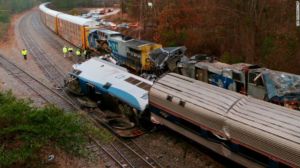Reading the Federal Tea Leaves: No Funds for Light Rail Expansion?
The new chair of the Met Council has had a tough first year on the job. Ever since Alene Tchourumoff took over, it’s been one crisis after another.
The bad news was a double-header this week.
First, the general counsel at BNSF Railroad told the Met Council that it absolutely would not consider locating its freight line with the 13-mile Bottineau LRT passenger rail planned between Minneapolis and Brooklyn Park. Reaching agreement with BNSF is required before the project would be granted federal matching funds under a program called New Starts.”
The main reason? Freight trains derail. If they derail when running next to passenger rail, they kill lots of people. Second, it crowds out growth for freight service.
Here is an excerpt from the letter BNSF sent to the Met Council:
“BNSF is not prepared to proceed with any discussion of passenger rail in this corridor at this time,” wrote BNSF vice president and senior general counsel Richard E. Weicher in a letter dated Jan. 9, 2018.
“As we explained in discussions some time ago, we do not believe the Blue Line light rail project would be consistent with our passenger principles or protect the long-term viability of freight service along the Monticello Subdivision,” Weicher wrote.

The Bottineau LRT, much like Southwest LRT, have been “done deals” as far as the Met Council is concerned since they conceived the projects years ago. Yet it sounds like BNSF made it clear “some time ago” that it was not interested in a deal.
Recall that BNSF demanded and got an agreement for a $20 million-dollar wall along the Southwest LRT where the lines run side by side for about 1.4 miles—the wall would be ten feet high. The deal was struck in the final pre-construction stage of the SWLRT project, after design, environmental impact and engineering studies were supposed to be done.
If BNSF gets a crash wall along the Bottineau route, the wall would have to be up to eight miles long where the lines co-locate. Forget the cost for a moment, imagine the impact of that ten-foot high wall on the residents of Minneapolis and these northern suburbs.
Why didn’t the Met Council get these “details” handled before committing to and spending taxpayer money on these projects?
If BNSF does not budge, the Met Council would have to find a new rail route for the Botttineau line and start its application with the Federal Transit Administration (FTA) all over. The application is currently pending in the engineering stage but far from approved. Since finding a new route is unlikely, why not drop LRT in favor of a top-flight bus system on existing and improved roads?
In a not-unrelated development, the president released his suggested budget for Congress to consider (he does not set the budget, Congress does). His budget blueprint included plans for an infrastructure program that significantly dials back federal funding and requires states to come up with most of the money for in-state projects.
According to the Wall Street Journal yesterday, Trump wants to “save more than $1.4 billion by eliminating the Federal Transit Administration’s New Start’s program, though it would permit projects that already have signed agreements to be funded through those grants to proceed.” This has been the President’s position since he came into office. He wants states to have skin in the game to avoid the hazard of “free’ federel money driving boondoggle projects like LRT in Minnesota.
As I have reported to you before, neither of the Met Council’s New Start’s projects, Southwest or Bottineau LRT, have signed agreements with the FTA.
That does not mean that the feds spurred on by Minnesota’s two U.S. Senators would not find the money and fund these LRT expansions. There is a lot of pressure from chamber groups, labor and the construction companies to spend the five-plus billion required for LRT expansion, plus all the maintenance and future replacement work.
But given that Congress is spending money like a drunken sailor, and it hasn’t figured out how to dial back entitlement spending which is now almost 70% of federal outlays, I am optimistic that the feds will have to take the money from boondoggles like Southwest and Bottineau, and hopeful that Congress and the states will spend it on infrastructure that we actually need.
[Photo from Tim Dominick/The State]